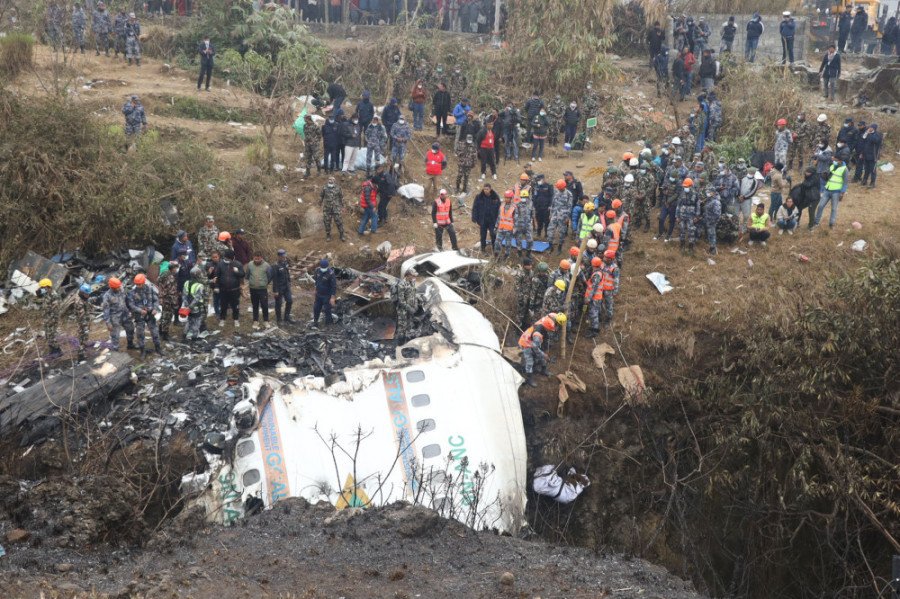Money
Feathered propellers resulted in loss of thrust, says crash report
Human error led to the crash of the Yeti plane in Pokhara, a probe panel member said.
Sangam Prasain
The propeller blades of the crashed Yeti Airlines ATR 72-500 were in the feathered position which caused the aircraft to lose thrust and fall, a preliminary report issued on Wednesday said.
All 72 people on board were killed in the accident in Pokhara that occurred in clear weather, as horrified residents watched from their rooftops.
According to experts, the propellers on an aircraft ‘feather’, which means the propeller blades are rotated, to reduce drag when engine power is lost. In this position, the plane is not being pushed forward and it stalls.
It is rare for the propellers of both engines to come to a feathered position, according to ATR pilots. Feathering is typically undertaken to reduce drag in the event of an engine failure.
So what happened with the Yeti Airlines ATR 72-500 bearing the registration number 9N-ANC?
“We are analysing the matter. It’s a human error,” said Buddhi Sagar Lamichhane, member secretary of the five-member probe commission formed by the government. “No engine failure has been reported. There are many factors that we have to analyse.”
According to experts the Post talked to, the pilots unintentionally pulled the condition levers causing the engine to shut down and feather the propellers. Each lever starts and stops the fuel supply, and controls the idle speed for its respective engine.
One investigator told the Post that they found the levers pulled down at the crash site.
“The details are awaited. We cannot ascertain what happened now,” said Lamichhane. “Yes, there is also the issue of flaps. There are questions about why the pilots delayed extending the flaps. The routine checklists were not followed. There are many factors to look at.”
As per International Civil Aviation Organisation (ICAO) Annex 13, the state conducting the investigation of an accident or incident must produce a preliminary report within 30 days of the accident.
A publicly available final report should be produced within 12 months of the accident.
On January 15, the Yeti Airlines flight NYT 691 arriving from Kathmandu was making the approach from the west to Runway 12. Pokhara's brand new international airport had been inaugurated only two weeks earlier.
The plane took off from Kathmandu at 10:32 am and the crash occurred at 10:57 am after reaching Pokhara.
According to the preliminary report, the flight crew had made two flights between Kathmandu and Pokhara earlier in the morning. The flight that crashed was the third in a row by the same crew.
There were two captains on the plane. Captain Anju Khatiwada was in the process of obtaining aerodrome familiarisation for operating in Pokhara, and Captain Kamal KC was the instructor pilot on this training flight.
Captain Khatiwada was on the left-hand seat and was flying the plane. The instructor pilot Captain KC sat on the right-hand seat and was monitoring her.

During the first contact with Pokhara tower, the air traffic controller had assigned Runway 30 for landing. But during the later phases of the flight, the crew requested and received clearance from the air traffic controller to land on Runway 12.
At 10:56:12, the pilots extended the flaps to the 15 degrees position and pushed the landing gear lever to the down position.
At 10:56:27, Khatiwada disengaged the autopilot system at an altitude of 721 feet above the ground.
Khatiwada then called for “FLAPS 30” at 10:56:32, and Captain KC replied, “Flaps 30 and descending.”
The flight data recorder (FDR) did not record any flap surface movement at that time, the report said.
Instead, the propeller rotation speed of both engines decreased simultaneously to less than 25 percent and the torque, the force that causes an opposite rotation, started decreasing to zero percent, which is consistent with both propellers going into the feathered condition, the report said.
The flight crew then carried out the “before landing checklist” before starting the left turn on to the base leg. In that time, the power lever angle increased from 41 percent to 44 percent.
At this point, the rotation speed of both propellers was recorded as non-computed data, unreliable data output caused by a condition other than a system failure in the flight data recorder.
When the propellers are feathered, they don’t produce thrust that pushes the aircraft forward.
As per the flight data recorder, no recorded parameters related to the engines showed any anomaly.
At 10:56:50, when the aircraft was at 500 feet, a “click” sound was heard. The aircraft reached a maximum bank angle of 30 degrees at this altitude.
The recorded propeller rotation speed and torque data remained invalid.
Khatiwada asked KC whether to continue the left turn and KC told her to continue the turn. Subsequently, Khatiwada asked KC whether to continue to descend, and KC said it was not necessary and told her to apply a little power.
At 10:56:54, another click was heard, followed by the flaps’ surface movement to the 30 degrees position.
When the air traffic controller gave the clearance for landing at 10:57:07, Captain Khatiwada twice mentioned that there was no power in the engines.
At 10:57:11, the power levers were advanced first to 62 degrees, and then to the maximum power position. It was followed by a “click” sound at 10:57:16.
One second after the “click” sound, the aircraft was at the initiation of its last turn at 368 feet above ground level, and the high-pressure turbine speed of both engines increased from 73 percent to 77 percent.
“It is noted that Khatiwada handed over control of the aircraft to KC at 10:57:18,” the report said.
At 10:57:20, Khatiwada, who was previously commanding the plane, repeated that the engines were not producing any power.
At 10:57:24 when the aircraft was at 311 feet above ground level, the stick shaker was activated, warning the crew that the aircraft's angle of attack had increased up to the stick shaker threshold.
A stick shaker acts as a stall-warning device.
At 10:57:26, a second sequence of stick shaker warnings was activated when the aircraft banked towards the left abruptly. At 200 feet, the stick shaker ceased.
At 10:57:32, the sound of impact was heard in the cockpit voice recorder. The flight data recorder and cockpit voice recorder stopped recording at 10:57:33 and 10:57:35 respectively.
The report said that the aircraft's airworthiness certificate was valid till April 24, 2023.
The wind speed was light at 3 to 5 knots. The prevailing visibility was 6 km, and the temperature was measured at 14 degrees Celsius.
Nepal’s investigators have received analytical support from Singapore’s Transport Safety Investigation Bureau.
This is Nepal's third deadliest air accident and the worst in domestic aviation. More than four million passengers fly domestic carriers annually.
The disaster is the second in under a year, highlighting the country's consistently poor air safety record, analysts said.
The commission has issued an interim recommendation to the Civil Aviation Authority of Nepal to conduct a comprehensive study to determine whether Runway 12 is an appropriate flight path that allows for a stabilised visual approach.
One investigator pointed out serious lapses by the regulator, the Civil Aviation Authority of Nepal, for allowing flights to an untested airport.
“We have recommended stopping flights from Runway 12 until a comprehensive analysis is done,” said Lamichhane.
The airport was hastily inaugurated and operated without adequate preparations to meet the January 1 project deadline. Flight calibration, which tests all pieces of equipment at the new airport, has yet to recommend landing from the west. The calibration report is due to be published on February 26.
The flight procedure has not been published either. Airlines have very little information about airport procedures and data, according to experts.
An evaluation as required by the safety management system was carried out, neither by the civil aviation regulator, as a service provider of the airport, nor by the airlines, a former chief of the Civil Aviation Authority of Nepal told the Post in a recent interview.
“The civil aviation body has misused its regulator role to operate the airport neglecting safety requirements. This is a serious crime and mass murder, and subject to a criminal investigation.”
The air traffic controller at a new airport should also have a specific rating. But in Pokhara, no one has it.




 6.31°C Kathmandu
6.31°C Kathmandu















